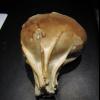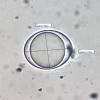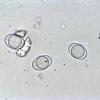
22-04-2015 20:47
 François Valade
François Valade
BonjourEn cherchant un Pyrenopeziza poussant sur t

23-04-2015 22:25
 Bernard CLESSE
Bernard CLESSE
Voici ce que je pense être Trochila craterium mai

12-04-2015 21:50
 Jenny Seawright
Jenny Seawright
Hello all, Back in the Nectria minefield but hopin

21-04-2015 20:27
Quijada LuisHi All, I am trying to obtain all the bibliograph
Is there another Helvella it might be?
Thanks
Mal

Mal
Regards, Till
I have measured some hundreds of spores of H. acetabulum that is a rather common species and that I see every year in hundreds of ascomata. Many times I have searched for the differences mentioned by Dissing (who examined the original material of H. unicolor in the Boudier's herbarium) as follows:
"H. unicolor can be separated from H. acetabulum and H. costifera on its very broad spores and on characters of anatomy".
The difference from H. costifera is clear, but with H. acetabulum I never understood well what can be the difference "on characters of anatomy". So I think the only chance to learn something more is to find and study carefully some very broad-spored collections of "H. acetabulum".
Malcolm's collection could be a chance to do this, as in my measurements the spores of H. acetabulum are normally 11,5-14,5 µm broad. I have never seen spores x 16-17,5. This might not be enough to recognize another taxon, but a careful investigation should be done.
Mal, was it an abundant collection or it was just one apothecium? The spore size is the same in others specimens? This is the first step.
Thank you to keep me updated with this collection.
Regards
Mario
Well, I don't know exactly what to search for. Maybe the best thing is to compare carefully the characters with those of a "typical" H. acetabulum. If you want to send me the specimen I would be happy to examine it. I send you my address by mail.
Thank you
Mario




